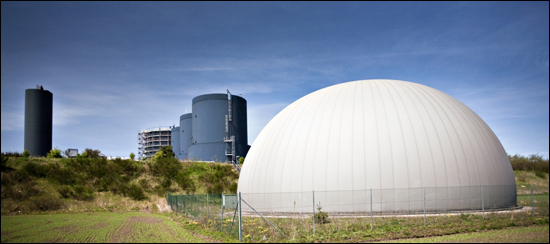
Biogas technology is not a recent invention, but is one of the bioenergy technologies that generates most interest at the moment. This is because it can make use of raw materials that have no intrinsic value as feed or food, it can improve nutrient use efficiency of slurry, and it can abate a considerable amount of greenhouse gas.
Large greenhouse gas substitution
Biogas production from slurry and other biomasses can replace fossil fuel, which improves the greenhouse gas balance of agriculture.
However, biogas technology is not only greenhouse gasreducing, it is actually greenhouse gas negative. In popular terms this means that the more biogas from animal manure you use, the better it is for the climate. There are two reasons for this.
One reason is that the treatment of slurry to produce biogas results in less methane being emitted into the atmosphere during subsequent storage of the slurry.
As methane is a powerful greenhouse gas (about 20 times more powerful than CO 2, seen over a period of 100 years), it has a large effect on the greenhouse gas balance of the biogas technology. The reduction due to reduced emission of methane from slurry storage tanks is almost as large as the reduction caused by the subsequent use of the biogas to substitute fossil fuel.
It would also appear that the digestion of slurry reduces the subsequent formation of nitrous oxide (N2O) when the slurry is applied to the field. In the biogas process bacteria convert degradable organic matter into methane and CO 2. There is therefore less organic matter left to be degraded in the soil after application. This reduces the risk of emission of N2O, which is a powerful greenhouse gas.
The greenhouse effect at N2O is about 300 times that of CO 2.
Improved nitrogen use efficiency
After the slurry is degraded in the biogas plant, the nitrogen in the slurry is in a form that is more readily available to plants. This means that more nitrogen is available for uptake in plants in the early growing season following field application, and the risk of loss to the environment is thus reduced.
The size of the effect does, however, depend on how the regulations for the incorporation of digested slurry in the nutrient budget are formulated.
In terms of the nitrogen turnover in organic farming, it seems to be considerable advantages in harvesting green manure and digesting this with the slurry. Partly you avoid crop decomposition in wet soil during the winter with a considerable risk of N2O emissions, and partly you can transfer the nitrogen and other nutrients from the green manure to other crops where it can be applied at a time when the potential for plant uptake is larger and the risk of N2O emissions is smaller.